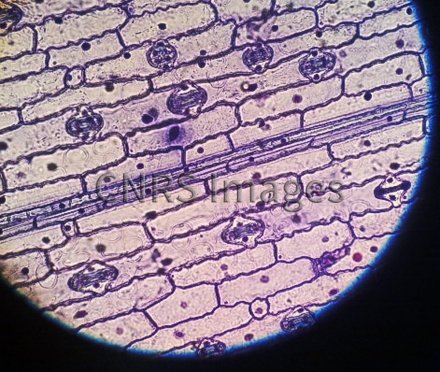Production year
2014

© Adrienne RESSAYRE / GQE - Le Moulon / CNRS Images
20170092_0048
Maize epidermal tissue, viewed through an optical microscope. Cell walls and nucleus membranes are stained with toluidine blue dye. Four different cell types can be seen. The large oblong cells are mesophyll cells. The egg-shaped structures are stomata, accompanied by two guard cells. This fragment of epidermis is divided into two parts by a rib: the large, elongated cells of the perivascular sheath surround the (invisible) vascular tissue. The blue colouring of the walls, and the serrated shape of the mesophyll cells are characteristic of an adult leaf. A major development milestone occurs when the plant stops producing juvenile leaves and produces adult leaves. It is then able to produce reproductive organs. This transition may occur at various ages, depending on the genotype, and will affect the plant's flowering date. Scientists at the Quantitative Genetics and Evolution unit in Le Moulon are studying the genetic, epigenetic and molecular control of qualitative and quantitative characteristics and their importance in the adaptation and evolutionary history of plant species. They optimise selection processes based on target characteristics (such as growth, development and adaptation), taking advantage of breakthroughs in genomics and genetic resources, and allowing for changes in environmental conditions and farming methods.
The use of media visible on the CNRS Images Platform can be granted on request. Any reproduction or representation is forbidden without prior authorization from CNRS Images (except for resources under Creative Commons license).
No modification of an image may be made without the prior consent of CNRS Images.
No use of an image for advertising purposes or distribution to a third party may be made without the prior agreement of CNRS Images.
For more information, please consult our general conditions
2014
Our work is guided by the way scientists question the world around them and we translate their research into images to help people to understand the world better and to awaken their curiosity and wonderment.